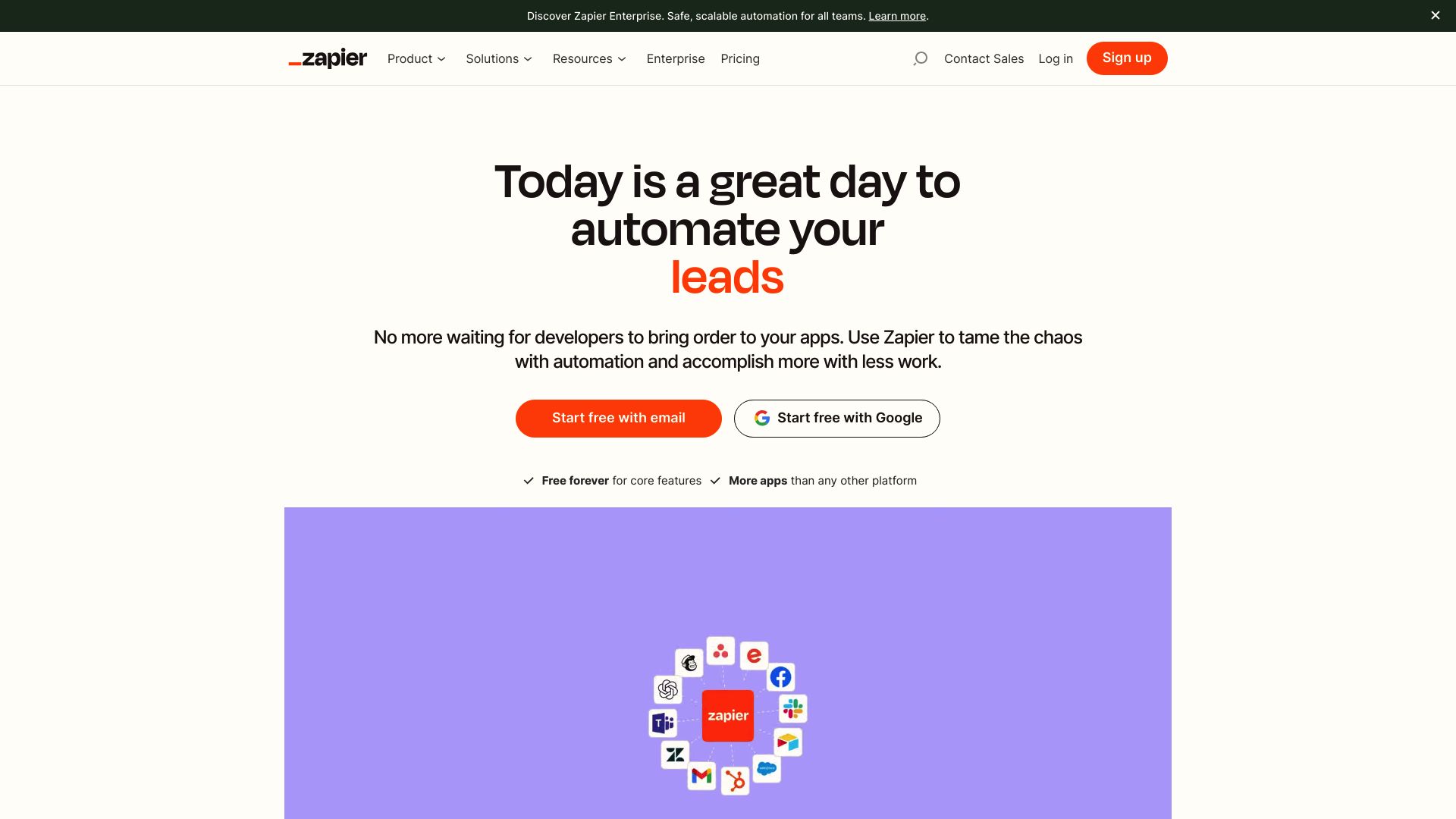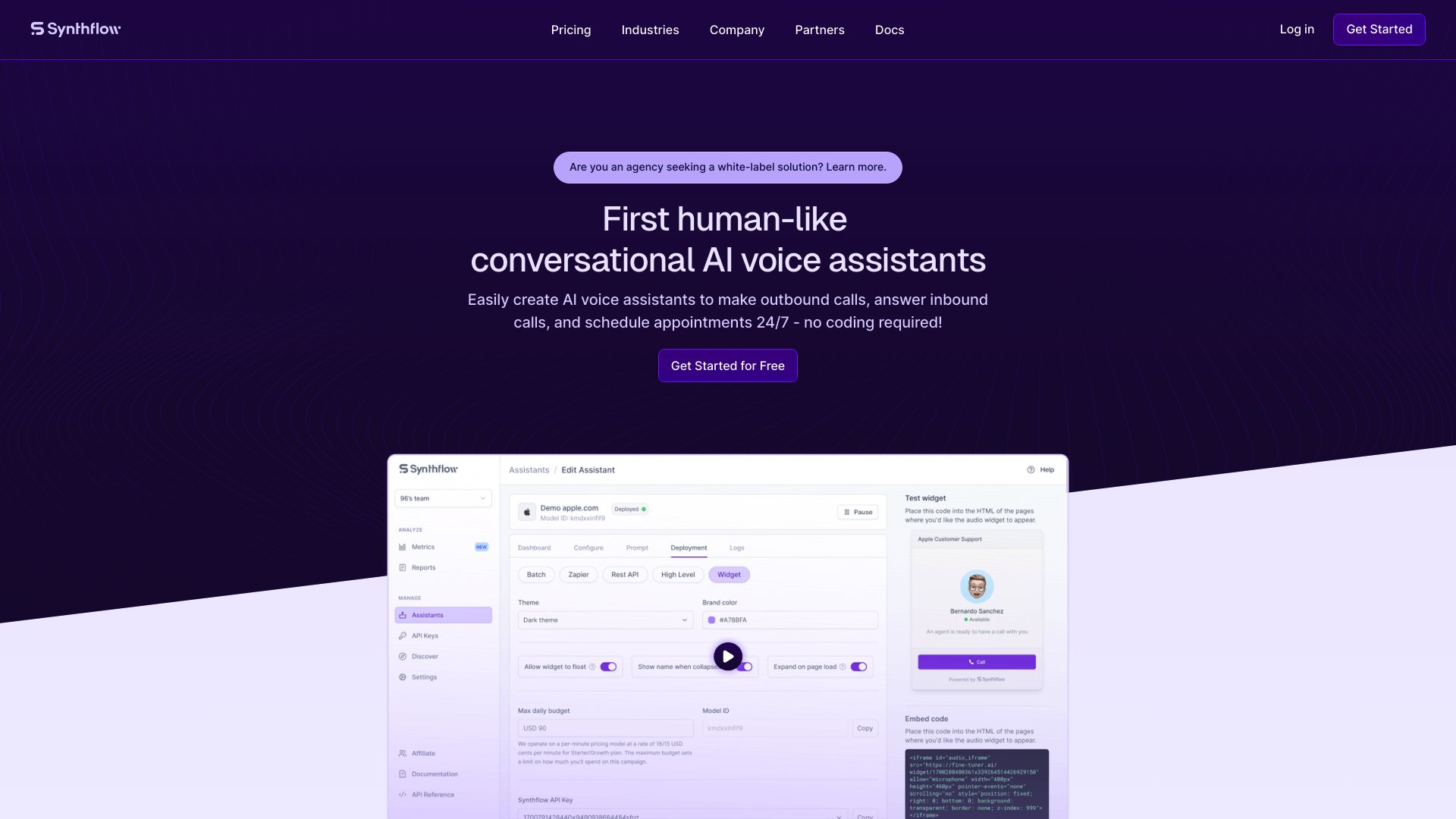Zapier vs. Synthflow: AI Automation Tools Compared
AI-powered tools revolutionize business operations, but choosing the right platform can be daunting. This comparison explores Zapier vs. Synthflow, and SmythOS, three distinct solutions addressing automation and AI integration needs. Zapier connects thousands of apps for streamlined workflows, while Synthflow specializes in no-code AI voice assistants. SmythOS emerges as a comprehensive AI agent development platform, combining ease of use with advanced capabilities.
We’ll dissect each platform’s strengths, limitations, and ideal use cases, empowering you to make an informed decision that aligns with your business goals and technical requirements. Whether you’re a developer seeking robust API integrations, a business leader focused on scalability and security, or a non-technical user looking for accessible AI solutions, this analysis provides valuable insights to guide your choice in the evolving AI landscape.
Zapier Overview
Zapier empowers users to connect and automate workflows between thousands of apps and services without coding. The platform’s visual interface allows creating “Zaps” — automated processes that transfer data between applications, triggering actions based on specific events.


Zapier’s strength lies in its vast library of over 6,000 app integrations, catering to businesses of all sizes seeking to streamline operations. The platform shines in automating repetitive tasks like data entry, notifications, and lead management. Its no-code approach makes it accessible to non-technical users, while developers can leverage the Platform CLI for custom integrations.
Zapier’s strength lies in its vast library of over 6,000 app integrations, catering to businesses of all sizes seeking to streamline operations.
While Zapier excels at connecting disparate systems, it lacks built-in AI capabilities. The platform focuses on rule-based automations rather than intelligent agents or natural language processing. This limitation may impact users needing more advanced AI-driven workflows or conversational interfaces.
Zapier’s ecosystem extends beyond simple integrations. The platform offers features like multi-step Zaps, scheduling, and conditional logic to create sophisticated automation flows. However, users with complex AI requirements or those needing deep customization may find the platform’s capabilities restrictive compared to dedicated AI agent builders.
In the competitive landscape, Zapier stands out for its ease of use and breadth of integrations. Its focus on accessibility and quick implementation makes it ideal for businesses looking to rapidly deploy automations without extensive technical resources. However, organizations requiring advanced AI functionalities or highly specialized integrations may need to explore additional tools to complement Zapier’s offerings.
Synthflow Overview
Synthflow empowers businesses to create AI voice assistants without coding expertise. The platform’s no-code interface and pre-built templates make AI technology accessible to users with varied technical backgrounds.


Synthflow’s AI assistants handle diverse tasks, from customer support to lead generation. The platform prioritizes data security, offering unlimited secure storage in a dedicated Pinecone environment. Integration capabilities with tools like 11Labs and Twilio enhance its functionality.
Synthflow’s AI assistants handle diverse tasks, from customer support to lead generation. The platform prioritizes data security, offering unlimited secure storage in a dedicated Pinecone environment.
The platform’s intuitive design allows users to create and manage AI agents effortlessly. Synthflow supports both batch deployments for large-scale communication campaigns and real-time interactions through website widgets. This flexibility caters to various business needs and scales of operation.
Synthflow’s vision centers on democratizing AI technology, making advanced customer engagement tools accessible to businesses regardless of their technical expertise. By streamlining operations and enhancing customer service, Synthflow aims to drive business growth across industries.
While Synthflow excels in user-friendliness and versatility, it lacks some advanced features found in more developer-oriented platforms. The focus on voice assistants may limit its applicability for businesses seeking broader AI agent capabilities. Additionally, the platform’s reliance on third-party integrations for enhanced functionality could potentially introduce complexity in implementation and maintenance.
Feature Comparison
Zapier and Synthflow offer distinct approaches to automation and AI integration, with notable differences in their core capabilities. Zapier excels in connecting disparate web apps and services, boasting over 6,000 pre-built integrations. Its visual workflow builder enables users to create automated processes without coding expertise. However, Zapier lacks native AI agent capabilities and focuses primarily on rule-based automations.
Synthflow, in contrast, specializes in AI voice assistant creation without requiring coding skills. It provides a no-code interface for building customizable AI agents capable of handling tasks like customer support and lead generation. Synthflow emphasizes data security, offering unlimited secure storage in a dedicated environment. While Synthflow shines in voice AI development, it may have limitations for users seeking broader AI agent functionalities beyond voice interactions.
SmythOS bridges these gaps by offering a comprehensive AI agent development platform. Unlike Zapier’s limited AI capabilities and Synthflow’s focus on voice assistants, SmythOS provides tools for creating versatile AI agents with advanced features like multi-agent collaboration, problem-solving capabilities, and deployment flexibility. SmythOS supports both visual building and code-based customization, catering to users with varying technical expertise. Its robust security features, scalability options, and support for diverse data sources position it as a more holistic solution for businesses seeking to leverage AI across multiple domains.
Feature Comparison Table
| Zapier | Synthflow | SmythOS | |
|---|---|---|---|
| CORE FEATURES | |||
| AI Agents | ❌ | ✅ | ✅ |
| Hosted Agents (Dev, Production) | ❌ | ✅ | ✅ |
| Memory & Context | ❌ | ✅ | ✅ |
| Autonomous Agents | ❌ | ✅ | ✅ |
| Explainability & Transparency | ❌ | ✅ | ✅ |
| Multimodal | ❌ | ❌ | ✅ |
| Problem-Solving Capabilities | ❌ | ✅ | ✅ |
| Multi-Agent Collaboration | ❌ | ✅ | ✅ |
| Human-AI Interaction | ❌ | ✅ | ✅ |
| Agent Work Scheduler | ❌ | ✅ | ✅ |
| SECURITY | |||
| Constrained Alignment | ❌ | ✅ | ✅ |
| IP Control | ❌ | ❌ | ✅ |
| COMPONENTS | |||
| Foundation AIs | ❌ | ✅ | ✅ |
| Huggingface AIs | ❌ | ❌ | ✅ |
| Classifiers | ❌ | ❌ | ✅ |
| Logic | ❌ | ✅ | ✅ |
| Data Lakes | ❌ | ❌ | ✅ |
| DEPLOYMENT OPTIONS (EMBODIMENTS) | |||
| Staging Domains | ✅ | ❌ | ✅ |
| Production Domains | ✅ | ❌ | ✅ |
| Deploy as Site Chat | ❌ | ✅ | ✅ |
| Deploy as Scheduled Agent | ❌ | ✅ | ✅ |
| Deploy as GPT | ❌ | ✅ | ✅ |
| DATA LAKE SUPPORT | |||
| Hosted Vector Database | ❌ | ✅ | ✅ |
| Sitemap Crawler | ❌ | ✅ | ✅ |
| YouTube Transcript Crawler | ❌ | ✅ | ✅ |
| URL Crawler | ❌ | ❌ | ✅ |
| PDF Support | ❌ | ❌ | ✅ |
| Word File Support | ❌ | ❌ | ✅ |
| TXT File Support | ❌ | ❌ | ✅ |
Best Alternative to Zapier and Synthflow
SmythOS stands out as the superior alternative to Zapier and Synthflow, offering a comprehensive AI agent development platform that bridges the gaps between these competitors. Our platform combines the best of both worlds, providing robust automation capabilities and advanced AI functionalities in a user-friendly package.
Unlike Zapier’s limited AI features and Synthflow’s narrow focus on voice assistants, SmythOS empowers users to create versatile AI agents capable of tackling a wide range of tasks. We offer a visual builder that simplifies the development process, making it accessible to users with varying levels of technical expertise. This approach democratizes AI development, allowing businesses to harness the power of artificial intelligence without extensive coding knowledge.
SmythOS empowers users to create versatile AI agents capable of tackling a wide range of tasks… making it accessible to users with varying levels of technical expertise.
One of SmythOS’s key advantages is its extensive feature set. We support multi-agent collaboration, enabling teams of AI agents to work together on complex tasks. Our platform also excels in problem-solving capabilities, allowing agents to analyze data, make decisions, and adapt to new situations. These features go far beyond the rule-based automations of Zapier or the voice-centric approach of Synthflow.
Scalability and flexibility are at the core of SmythOS. We offer multiple deployment options, including APIs, webhooks, and chatbots, ensuring that our AI agents can integrate seamlessly into existing workflows and systems. This versatility, combined with our support for a wide range of data sources and file types, positions SmythOS as the ideal choice for businesses looking to implement AI solutions across various domains and use cases.
We offer multiple deployment options… ensuring that our AI agents can integrate seamlessly into existing workflows and systems.
In terms of security and compliance, SmythOS doesn’t compromise. We provide robust data encryption, OAuth integration, and IP control features, addressing the critical concerns of data protection and access management. These security measures, coupled with our platform’s scalability and performance optimization, make SmythOS well-suited for enterprise-level deployments while remaining accessible to smaller organizations.
Conclusion
Zapier’s extensive integration library and user-friendly interface make it a powerful tool for connecting disparate apps and automating workflows. Its no-code approach appeals to businesses seeking quick implementation of rule-based automations. Synthflow, on the other hand, excels in creating AI voice assistants without coding, offering a specialized solution for businesses looking to enhance customer engagement through conversational AI.
While both platforms offer unique strengths, SmythOS emerges as the superior choice for businesses seeking comprehensive AI agent development and deployment. Our platform combines the best of both worlds — the ease of use found in Zapier and the AI capabilities of Synthflow — while extending far beyond their limitations. SmythOS’s drag-and-drop interface, coupled with advanced features like multi-agent collaboration and problem-solving capabilities, empowers users to create sophisticated AI workflows without sacrificing simplicity.
SmythOS stands out with its versatile deployment options, allowing users to integrate AI agents seamlessly across various platforms and services. This ’Create Once, Deploy Anywhere’ approach, combined with our robust security features and scalability options, positions SmythOS as the ideal solution for businesses of all sizes looking to leverage AI across multiple domains. Explore our diverse range of AI-powered agent templates to jumpstart your AI journey and discover how SmythOS can transform your workflow. Experience the future of AI automation — try SmythOS today and unlock the full potential of intelligent agents for your business.
Last updated:
Disclaimer: The information presented in this article is for general informational purposes only and is provided as is. While we strive to keep the content up-to-date and accurate, we make no representations or warranties of any kind, express or implied, about the completeness, accuracy, reliability, suitability, or availability of the information contained in this article.
Any reliance you place on such information is strictly at your own risk. We reserve the right to make additions, deletions, or modifications to the contents of this article at any time without prior notice.
In no event will we be liable for any loss or damage including without limitation, indirect or consequential loss or damage, or any loss or damage whatsoever arising from loss of data, profits, or any other loss not specified herein arising out of, or in connection with, the use of this article.
Despite our best efforts, this article may contain oversights, errors, or omissions. If you notice any inaccuracies or have concerns about the content, please report them through our content feedback form. Your input helps us maintain the quality and reliability of our information.
